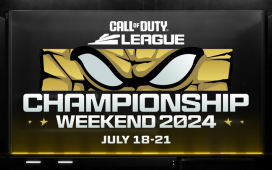Mentioned in this article
In video games, community contributions have been used to fund game development, build desperately needed hardware, and in esports, extend tournament prize pools to a (current) record of $34.3M USD. The financial goodwill of gamers also extends to charitable goodwill, with both the corporate and community sides of the industry regularly stepping up for a shared cause.
You can see this playing out in real-time right now. Wildfires continue to ravage Australia, predominantly the south-east of the country, and have at the time of publication led to the deaths of 28 people, the destruction of over 5,900 buildings (including over 2,200 homes), and is expected to cost the country $5B USD in direct losses.
This prompted some members of the Overwatch game community to publicly ask the developer and publisher, Blizzard Entertainment, to create a set of firefighter themed skins (character outfits) for the Australian characters Junkrat and Roadhog, with all proceeds to go towards fighting the fires.
The community affirmed this call tens of thousands of times over, and there is a precedent for such items to be made. In 2018, Blizzard raised $12.7M for the Breast Cancer Research Foundation (BCRF) through 100% of sales of a $15 limited edition skin. Blizzard has so far not publicly commented on the call for Aussie firefighting skins, but that doesn’t mean it won’t happen. Games publishers tend to be careful when making public statements, even if it’s about doing good deeds with their dollars.
After all, it takes development time and resources to design new cosmetic items, not to mention coordinating the update that will introduce them in the game. Marketing channels must also align to raise awareness of the campaign. Last but not least are the legal barriers that must be breached in order to ensure funds reach the right state authorities in Australia (compared to the BCRF campaign, which was a payment to a single organization).
Perhaps Blizzard could start accepting donations now and deliver skins later, though this does highlight the thorny issue of donating to a cause through purchase, rather than pure philanthropy. Charity drives and awareness campaigns have been far more historically effective than a simple donation link. They reach people who might be outside the daily news cycle, and the skin would add as a lasting reminder of what is to be an ongoing plight, even once the wildfire season finishes.

Recurring causes are a staple of the gaming industry. Activision Blizzard recently announced the recipients of its “Call of Duty Endowment Awards,” providing a $30K grant to non-profits in the veteran’s employment sector. Having run for over seven years, the Endowment also hosted a CODE Bowl charity stream in December, featuring some of the most well-known Twitch personalities, all of whom raised donations through their own streams.
Like other charities of its kind, the goal is partly to improve company image, though the Endowment also turns the public stigma against shooting and war games into something positive for veterans. A large charitable foundation comes with plenty of tax incentives, but there are already more egregious uses of foreign game company subsidiaries to focus on.
Last year also saw the founding of the Riot Games Social Impact Fund, which has donated over $4M to a variety of causes. Amazon subsidiary Twitch, as well as being a major platform for charity drives, donates portions of its “bits” currency to charities, and at one point even donated $1M directly to a charity stream by Benjamin “DrLupo” Lupo.
Billion-dollar companies aren’t the only ambassadors of gaming that make a difference. The ability to reach thousands of fellow players in realtime has made telethon-style charity streams a regularly uplifting part of gaming culture. Twitch stated that its community raised more than $100M for charities since the site launched in 2011, and while playing games for hours on end is the backbone of this content, how you incentivize viewers (i.e. with auctions, prizes, or goals) is your call.
One of the most routinely successful movements is Games Done Quick (GDQ), which runs semiannual speedrun marathons. At these events, skilled players take turns beating games in the quickest possible time, for a live and digital audience. The charity has raised over $25.6M since 2010, with its first event of 2020 bringing in a record $3.1M for the Prevent Cancer Foundation.
Thank you so much for making #AGDQ2020 another record event!
This may be the end of AGDQ, but #SGDQ2020 will be here before you know it! We’ll see you in Bloomington, MN on June 21-28! pic.twitter.com/iuonSs334F
— Games Done Quick (@GamesDoneQuick) January 12, 2020
While speedruns are typically a serious affair, GDQ adds a lot of light-hearted conditions for players and audiences alike. Donors get their messages read aloud, which in the recent marathon, often contained personal stories of cancer regarding family and friends.
The format varies from blindfolded runs to head-to-head matches, and a bidding war is used to incentivize donations even further. For example, the first single donor to collectively offer $10K during the Final Fantasy VIII relay speedrun would force the runners to sing “Eyes on Me” from the game’s soundtrack. If $25K was bid, then the players would try to take down the game’s notoriously difficult super boss, Omega Weapon. Both goals were met. The song was sung, and the boss defeated.
This last aspect speaks to the appeal of charity streams. Again, players are being incentivized to be part of a campaign, rather than just donate directly to a given charity. The chance not to just be part of an event, but to influence it encourages a greater degree of altruistic behavior—however brief or sentimental that may be.
Donor motives are a huge subject matter within philanthropic studies, and while grueling challenges such as running a marathon or tipping an ice-bucket on yourself are undeniably effective, the “martyrdom effect” as its known doesn’t connect with everyone.
Gamers, like anyone who donates to charity, want to feel that they have agency. That could be hearing how much a charity drive raised, being able to showcase your support of a cause with a special edition character costume, or seeing your donation manifest as a ridiculous nickname in a speedrun.
Bottom line: gaming is a great example of turning consumer choice into charitable good.














